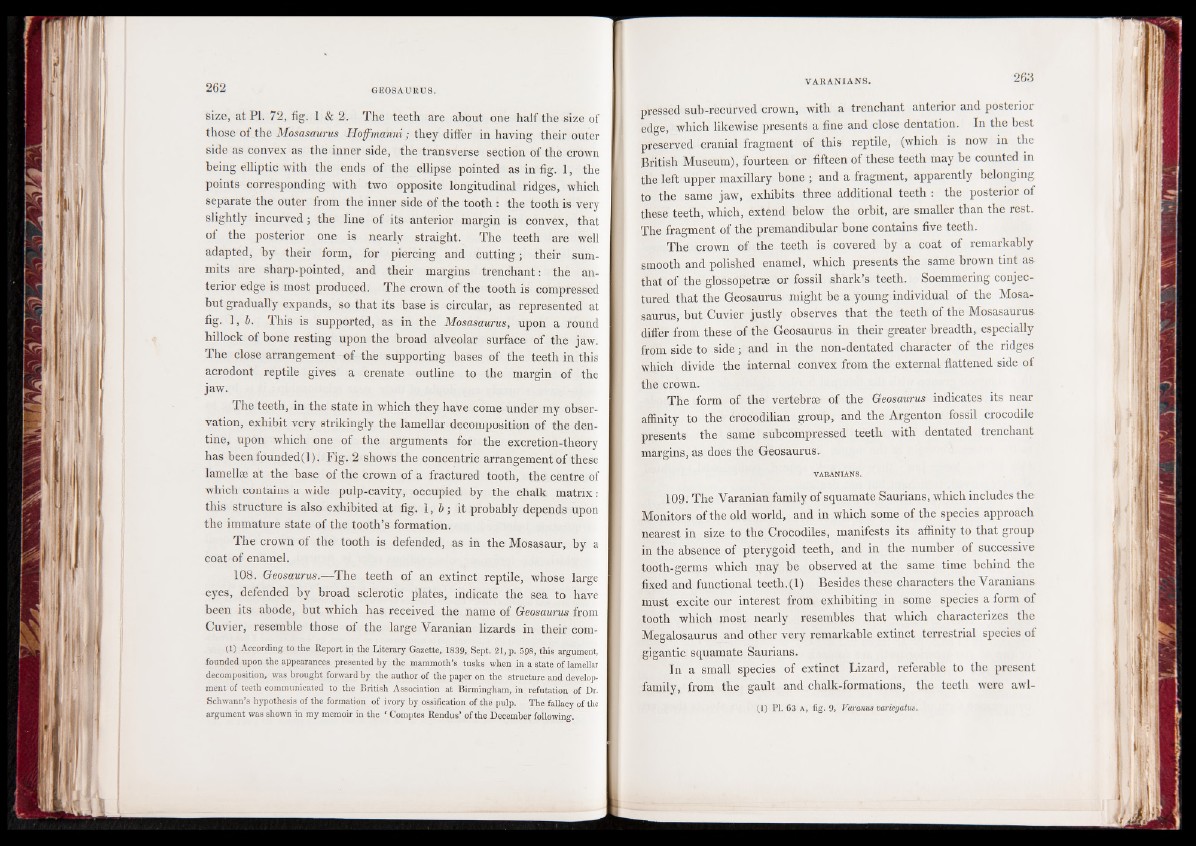
size, at PI. 72, fig. 1 & 2. The teeth are about one half the size of
those of the Mosasaurus Hoffmanni; they differ in having their outer
side as convex as the inner side, the transverse section of the crown
being elliptic with the ends of the ellipse pointed as in fig. 1 , the
points corresponding with two opposite longitudinal ridges, which
separate the outer from the inner side of the tooth : the tooth is very
slightly incurved; the line of its anterior margin is convex, that
of the posterior one is nearly straight. The teeth are well
adapted, by their form, for piercing and cutting; their summits
are sharp-pointed, and their margins trenchant: the anterior
edge is most produced. The crown of the tooth is compressed
but gradually expands, so that its base is circular, as represented at
fig. 1, 6. This is supported, as in the Mosasaurus, upon a round
hillock of bone resting upon the broad alveolar surface of the jaw.
The close arrangement of the supporting bases of the teeth in this
acrodont reptile gives a crenate outline to the margin of the
jaw.
The teeth, in the state in which they have come under my observation,
exhibit very strikingly the lamellar decomposition of the dentine,
upon which one of the arguments for the excretion-theory
has beenfounded(l). Fig. 2 shows the concentric arrangement of these
lamellae at the base of the crown of a fractured tooth, the centre of
which contains a wide pulp-cavity, occupied by the chalk matrix :
this structure is also exhibited at fig. 1 , 6 ; it probably depends upon
the immature state of the tooth’s formation.
The crown of the tooth is defended, as in the Mosasaur, by a
coat of enamel.
108. Geosaurus.—The teeth of an extinct reptile, whose large
eyes, defended by broad sclerotic plates, indicate the sea to have
been its abode, but which has received the name of Geosaurus from
Cuvier, resemble those of the large Yaranian lizards in their com-
(1) According to the Report in the Literary Gazette, 1839, Sept. 21, p. 598, this argument,
founded upon the appearances presented by the mammoth’s tusks when in a state of lamellar
decomposition, was brought forward by the author of the paper on the structure and development
of teeth communicated to the British Association at Birmingham, in refutation of Dr.
Schwann’s hypothesis of the formation of ivory by ossification of the pulp. The fallacy of the
argument was shown in my memoir in the ‘ Comptes Rendus’ of the December following.
pressed sub-recurved crown, with a trenchant anterior and posterior
edge, which likewise presents a fine and close dentation. In the best
preserved cranial fragment of this reptile, (which is now in the
British Museum), fourteen or fifteen of these teeth may he counted in
the left upper maxillary bone ; and a fragment, apparently belonging
to the same jaw, exhibits three additional teeth : the posterior of
these teeth, which, extend below the orbit, are smaller than the rest.
The fragment of the premandibular bone contains five teeth.
The crown of the teeth is covered by a coat of remarkably
smooth and polished enamel, which presents the same brown tint as
that of the glossopetrse or fossil shark’s teeth. Soemmering conjectured
that the Geosaurus might be a young individual of the Mosasaurus,
but Cuvier justly observes that the teeth of the Mosasaurus
differ from these of the Geosaurus in their greater breadth, especially
from side to side; and in the non-dentated character of the ridges
which divide the internal convex from the external flattened side of
the crown.
The form of the vertebrae of the Geosaurus indicates its near
affinity to the crocodilian group, and the Argenton fossil crocodile
presents the same subcompressed teeth with dentated trenchant
margins, as does the Geosaurus-
VARANIANS-
109. The Yaranian family of squamate Saurians, which includes the
Monitors of the old world, and in which some of the species approach
nearest in size to the Crocodiles, manifests its affinity to that group
in the absence of pterygoid teeth, and in the number of successive
tooth-germs which may be observed at the same time behind the
fixed and functional teeth.(1) Besides these characters the Varanians
must excite our interest from exhibiting in some species a form of
tooth which most nearly resembles that which characterizes the
Megalosaurus and other very remarkable extinct terrestrial species of
gigantic squamate Saurians.
In a small species of extinct Lizard, referable to the present
family, from the gault and chalk-formations, the teeth were awl-
(1) PI. 63 A, fig. 9> Varanus variegatus.